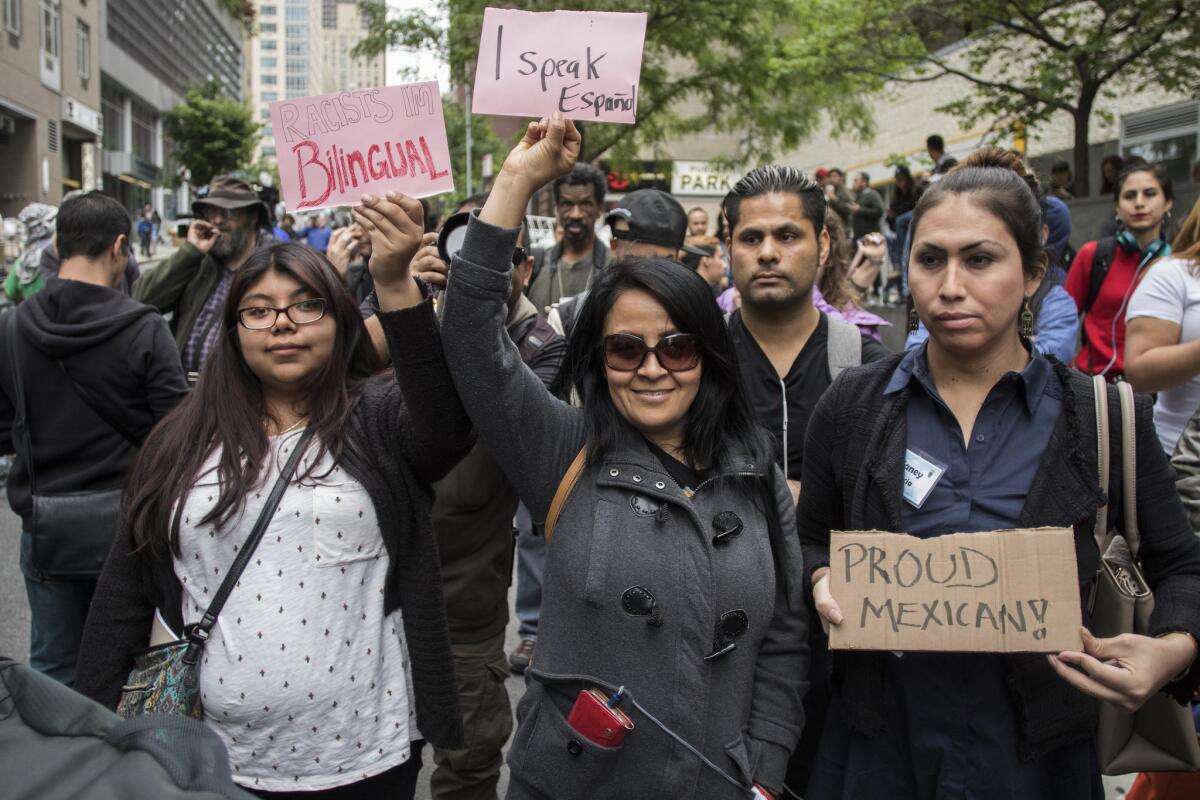‘You need to speak English’: Encounters in viral videos show Spanish is still polarizing in the U.S.

Natalia Meneses was shopping at a Walmart in Georgia this year when her 3-year-old daughter began a conversation that triggered an ugly experience.
The little girl did not blurt out a profanity or otherwise say anything inappropriate. She simply pointed out flower hair clips to her mother: “Mira, Mami!”
Overhearing the conversation that ensued in Spanish between mother and child, a woman snapped at Meneses, an American citizen who was born in Colombia.
“You need to teach this kid to speak English, because this is America and kids need to learn English,” she said. “If not, you need to get out of this country.”
An angry Meneses responded that both she and her daughter were American and spoke English.
Spanish, the first European tongue to take root in North America, has established itself as perhaps the most relentlessly polarizing language in the United States. Two decades ago it sparked an emotional debate in California about banning bilingual education, a topic that divided even Latino families. During heavy immigration into California and other border states, Spanish was the language of choice in whole neigborhoods.
Now, the presidency of Donald Trump has reignited the linguistic divide. Trump has railed against illegal immigration, attacked the character of those who cross the border and once said “this is a country where we speak English, not Spanish.”
At the same time, Spanish is making inroads in American pop culture. Luis Fonsi’s global hit “Despacito” broke numerous records on the pop charts and became the first YouTube video to hit 5 billion views.
“When we’re living in a world where symbols become dividing lines, language can be one of those,” said Brian Levin, director for the Center for the Study of Hate and Extremism at Cal State San Bernardino.
In this environment, two recent incidents seared themselves into the long tradition of people being berated for speaking Spanish, while also illustrating the power of video and social media to launch a counterattack.
In one case, New York attorney Aaron Schlossberg yelled at Latino restaurant workers at a Fresh Kitchen in Manhattan for speaking Spanish and threatened to report them to Immigration and Customs Enforcement.
“My guess is they are not documented, so my next call is to ICE to have each one of them kicked out of my country,” Schlossberg said in the recorded incident. “I pay for their welfare. I pay for their ability to be here. The least they can do ... is speak English.”
After a barrage of criticism that included an ironic serenade from a mariachi band, Schlossberg apologized on Twitter and said he is not racist.
The same week as the New York incident, a Border Patrol agent was recorded stopping two women in Montana and asking them for identification.
“Ma’am, the reason I asked you for your ID is because I came in here, and I saw that you guys are speaking Spanish, which is very unheard of up here,” the agent can be heard saying in the video.
A U.S. Customs and Border Protection spokesman said the incident is “being reviewed to ensure that all appropriate policies were followed.”
It’s hard to know whether there has been an uptick in confrontations over the speaking of Spanish. Such incidents have been reported for decades, and the share of Latinos who can speak Spanish has declined over the past decade, with 73% of Latinos speaking Spanish at home in 2015, down from 78% in 2006, according to a Pew Research Center analysis of Census Bureau data. Many Latinos grew up in households where only English is spoken.
Since the presidential election, dozens of Latinos have reported verbal assaults for speaking Spanish through Documenting Hate, a project that tracks bias incidents and hate crimes around the country. The reported incidents include insults over a truck driver radio channel, a confrontation in a movie theater and at a hotel pool.
“The prejudice against Spanish is not about Spanish the language; it’s about the people who speak Spanish,” said Carmen Fought, a linguistics professor at Pitzer College. “Who tend to be people of color, who tend to be people from a lower socioeconomic background and who, not always but sometimes, are immigrants and are in the center of a lot of negative targeting in the political arena.”
Although English is spoken by most people in the U.S., there is no official language designated for the country. There are at least 350 spoken in homes around the nation.
There were 40 million U.S. residents who spoke Spanish at home in 2016, according to census data. More than half — 57.5% of Latino Spanish speakers — spoke English “very well.”
Spanish has long inspired contradictory impulses. On the one hand, many middle-class and affluent whites have enrolled their children in bilingual charter schools so they could learn Spanish, believing it could give them a leg up in the job market. But the language has also inspired English-only initiatives across the country.
In a tweet, Republican strategist Ana Navarro wrote: “Let me get this straight. Just a few months ago, everybody in America — and the rest of the world — was going around singing every word of ‘Despacito.’ But now, they want to berate us and detain us when they hear us say a few words in Spanish?”
Since the election, there has been a rise in hate crimes and the emergence of bigotry in public spaces, Levin said, captured and widely shared on social media.
The attitude toward Spanish is reflective of the feelings toward German in the 19th and 20th centuries, when Germans were criticized for supposedly failing to assimilate. In some states, such as Nebraska and Iowa, laws were enacted to ban German in public schools.
Language can make someone “automatically suspect to someone who has nativist leanings,” said Heidi Beirich, director of the Intelligence Project at the Southern Poverty Law Center, which tracks extreme right-wing and hate groups.
“Spanish speakers and the idea of Spanish spreading in the United States has been a bugaboo for the far right for a long time,” Beirich said.
The Manhattan incident took the 40-year-old Meneses back to what happened to her at Walmart in March. The mother of two broke down in tears on the way to report it to store employees, who confronted the other woman.
“I was just doing her a favor,” Meneses recalled the woman saying. “That kid needs to learn English. It’s going to be a disadvantage for her, and I don’t want to pay my taxes for them to learn English.”
“What if I was white and speaking French to my kid in a Walmart. Was that lady going to attack me? No,” said Meneses, who is working on her doctorate. “What if I had a blonde kid and I would have been white and blonde haired and I would have been speaking Spanish, was she going to say something? No.”

Ana Suda cannot remember what she and her friend were discussing as they walked around a store in Havre, Mont., when the Border Patrol agent asked them where they were born.
After he took their IDs, Suda recorded a video asking the agent why he had asked for their identification.
Suda asked whether they were being racially profiled. The agent said no.
“It has nothing to do with that,” he said. “It’s the fact that it has to do with you guys speaking Spanish in the store, in a state where it’s predominantly English-speaking.”
Suda, who was born in El Paso and raised in Juárez, Mexico, said she often speaks Spanish in the town without incident. She speaks Spanish with her two children so they are able to communicate with family in Mexico.
After her 7-year-old daughter watched video of the interaction at the gas station, she approached Suda with a look of sadness.
“Mommy, I can’t speak Spanish anymore?” she asked.
“Of course you can,” Suda said. “You need to be proud. You speak two languages. You’re smart.”
In the fall of 2016, Jobana Townsend was in the cereal aisle of a Walmart in Susanville, Calif., when a couple of women overhead her speaking Spanish with her two children. Townsend, born in Hermosillo, Mexico, is a naturalized U.S. citizen.
At first, one of the women simply said aloud that she hated when people spoke Spanish. Townsend ignored her and kept speaking to her son and daughter.
Then, the woman turned and made it direct: “You need to speak English. This is America. We speak English.”
Townsend said nothing until she was in her car with her family, when she told them to never be ashamed of who they are. Her father, a U.S. born citizen and a military veteran, “fought for everyone to have the right to speak any language.”
“We’re not going to stop speaking Spanish just because other people are uncomfortable by it,” Townsend said. “Maybe the more they hear us the more they’ll see that we’re just like them. We just speak a different language on top of it.”
For more California news, follow @brittny_mejia.
More to Read
Start your day right
Sign up for Essential California for news, features and recommendations from the L.A. Times and beyond in your inbox six days a week.
You may occasionally receive promotional content from the Los Angeles Times.







